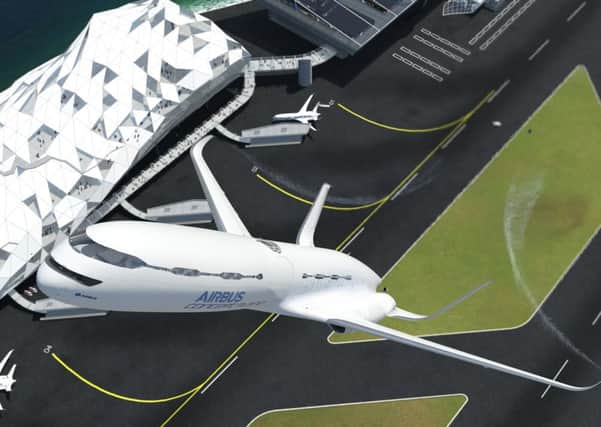Vision to ease crowded skies and make flying sustainable


This vision of the future of sustainable aviation was outlined at a conference in Yorkshire by a leading figure in the aerospace sector.
Colin Sirett, head of research and technology at Airbus in the UK, said that in the next 20 years air traffic will double. But in order to sustainably meet the expected growth in air travel, Airbus has set out a vision which looks beyond aircraft design to how aeroplanes are operated both on the ground and in the air.
Advertisement
Hide AdAdvertisement
Hide AdMr Sirett said: “We carried out a study a couple of years ago. Ten thousand of the population across the world who are going to be the new generation of travellers, what did they want out of it?
“Sixty seven per cent of them said they were going to travel more by air and (for) everyone we asked, the access to air travel became more and more important, irrespective of whether they have Skype, connectivity, virtual meetings, they wanted to have that experience of travelling the planet, but they wanted to do it more sustainably.”
Mr Sirett painted a picture of the global aircraft manufacturer’s ‘smarter skies’ vision for 2050 and beyond at the National Metals Technology Centre (Namtec) conference in Harrogate.
One element of this vision would see aircraft launched through assisted take-offs using renewably powered, propelled acceleration, allowing a steeper climb from airports to minimise noise and reach efficient cruise altitudes quicker. This approach could also minimise land use, as shorter runways could be used.
Advertisement
Hide AdAdvertisement
Hide AdMr Sirett said: “Eco-takeoff is about getting the aircraft into the sky as fast as possible to its cruising altitude.”
Meanwhile, formation flying, he said, is an area Airbus is already working on. High frequency routes would allow aircraft to benefit from flying in formation like birds during cruise bringing efficiency improvements due to drag reduction and lower energy use.
Mr Sirett said: ”It means you’d have to fly a lot closer to each other in the sky. Normal separation rules that we have today just wouldn’t apply, otherwise it wouldn’t work.
“But this could give up to, and there are debates as to whether it’s between 15 and 20 per cent reduction in fuel whilst you’re following.”
Advertisement
Hide AdAdvertisement
Hide AdHe added: “So this is something that is very close to what we could do today. We know our military colleagues, they have the systems which enable this. The challenge is to get those systems to operate in a commercial airspace and for it to be accessible by all aircraft.”
Other concepts include low-noise, free-glide approaches and landings. This would allow aircraft to take free-glide approaches into airports that reduce emissions during the overall descent and reduce noise during the steeper approach as there is no need for engine thrust or air breaking.
These approaches would also reduce the landing speed earlier which would make shorter landing distances achievable, according to Airbus.
Mr Sirett said: “Next one is how do we reduce emissions on the ground? We think of aircraft as things that fly. But each aircraft drives about 125,000 miles in its life.”
Advertisement
Hide AdAdvertisement
Hide AdTechnology could optimise an aircraft’s landing position with enough accuracy for an autonomous renewably powered taxiing carriage to be ready, so aircraft could be transported away from runways quicker.
Mr Sirett also spoke of the use of sustainable biofuels and other potential alternative energy sources to secure supply and further reduce aviation’s environmental footprint in the long term.
He said that aircraft is already flying today using oil generated by algae. “The way the algae produces the oil is by absorbing carbon dioxide from the atmosphere and all it needs is water and sunlight. So that is a big possibility for the future. Anywhere there is water around the world you could quite possibly have a station generating biofuel.”